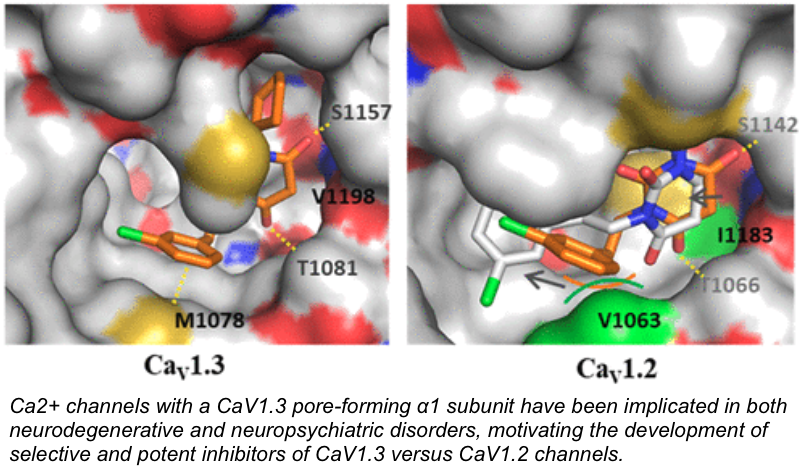Potent and selective Cav1.3 negative allosteric modulators for use in Parkinson's Disease
Case ID:
MKT-PROJ-25-0124
NU 2010-105 and NU 2024-179
INVENTORS
- Richard Silverman* (Northwestern University, Weinberg College of Arts & Science, Department of Chemistry)
- Dalton Surmeier Jr.* (Northwestern University, Feinberg School of Medicine, Chair of the Department of Neuroscience)
- Garry Cooper
- Soosung Kang
- Jack Nguyen
SHORT DESCRIPTION
For pharmaceutical developers targeting Parkinson’s disease, this technology portfolio provides selective Cav1.3 calcium channel antagonists and combination strategies. These approaches offer novel neuroprotection designed to slow disease progression by reducing mitochondrial stress in neurons.
BACKGROUND
Parkinson’s disease is a progressive neurodegenerative disorder affecting millions globally. Current treatments primarily manage symptoms but do not halt the underlying neurodegeneration. Many existing therapies also cause significant side effects, limiting their long-term utility. The lack of disease-modifying options creates a critical unmet need for innovative therapies that address the root causes of neuronal loss and slow the progression of the disease.
ABSTRACT
Preclinical studies have shown that Cav1.3 calcium channels increase oxidative stress in mitochondria. Recent clinical findings suggest that inhibiting Cav1.3 channels slows the progression of Parkinson’s Disease (PD), but current pharmacotherapies are limited by off-target effects in other calcium channels found in the brain and cardiovascular system. Northwestern University researchers have developed a series of potent and selective negative allosteric modulators targeting the Cav1.3 calcium channel. This portfolio includes novel compounds with pyrimidinetrione (PYT) and dihydropyridine (DHP) scaffolds. These antagonists selectively block channels implicated in Parkinson’s disease pathology. By targeting Cav1.3, the compounds aim to lower oxidative stress and mitigate dopaminergic neuron loss. In vivo laboratory studies validate the potential of this approach to enhance neuroprotection and slow disease progression.
MARKET OPPORTUNITY
The global Parkinson's disease therapeutics market was valued at $6.59 billion in 2024 and is projected to reach $13.34 billion by 2034, growing at a compound annual growth rate (CAGR) of 7.39% (Source: Precedence Research, 2025). This growth is driven by the rising prevalence of the disease in the aging global population, with over 10 million people affected worldwide, making this portfolio of selective Cav1.3 antagonists a strategic commercial opportunity.
DEVELOPMENT STAGE
TRL-4, Prototype Validated in Lab. Key functions of the lead compounds have been demonstrated in laboratory settings, validating the mechanism of action for neuroprotection.
APPLICATIONS
- Disease-modifying therapy for Parkinson's disease: Slows progression by reducing oxidative stress.
- Neurodegenerative disorders: Potential treatment for conditions involving calcium channel dysfunction.
- Drug development: Platform for innovative Cav1.3 antagonism strategies.
ADVANTAGES
- High selectivity for Cav1.3: Minimizes off-target effects associated with broader calcium channel blockers.
- Potent channel blockade: Demonstrates enhanced efficiency that may effectively slow disease progression.
- Novel mechanism of action: Introduces an innovative approach to achieve neuroprotection by targeting pathways involved in oxidative stress.
PUBLICATIONS
IP STATUS
Issued US Patent Nos. 9,428,467; and 10,105,366.
Patent Information:
| Title |
App Type |
Country |
Serial No. |
Patent No. |
File Date |
Issued Date |
Expire Date |
Categories:
Life Sciences > Therapeutics
Keywords:
Neurodegenerative disease
Neurologic disease
Neurology
PD - Parkinson's Disease